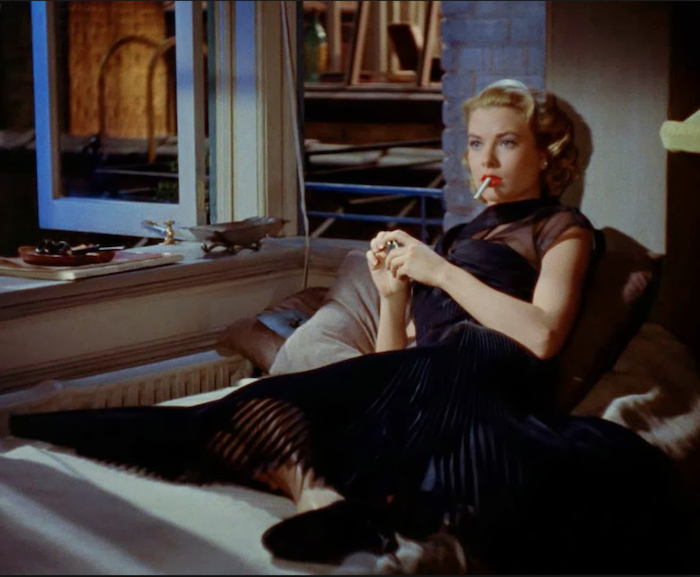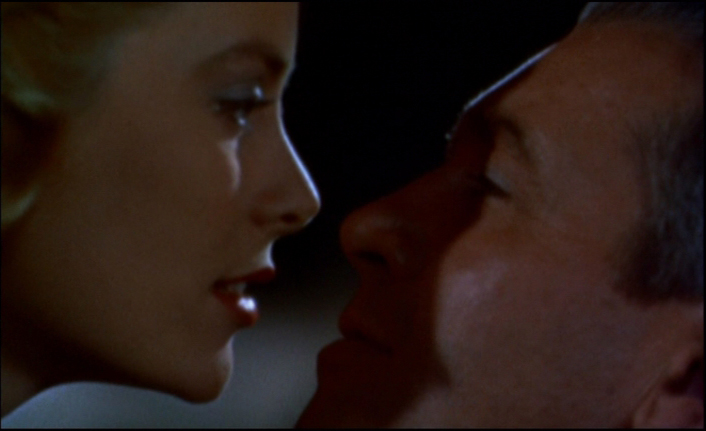Rear Window is more than one of Alfred Hitchcock’s greatest comedies of terrors. Set in a Greenwich Village apartment and its adjoining courtyards, this urban variation on the backyard-murder story is a once-over-lightly satire of the quality of modern life and a once-over-thoroughly exploration of the allure of voyeurism. Always a Hitchcock personal favorite, Rear Window (like Vertigo, The Trouble With Harry, the remake of The Man Who Knew Too Much, and Rope) was owned outright by the director; and since he wanted these films’ theatrical value to appreciate over the years, he made sure they would not get thrown into the dustbin of TV syndication. Only after his death, in 1980, did the Hitchcock estate negotiate for a rerelease. And the twenty-one-year hiatus after Rear Window’s last public screening prevented it from taking its proper place in film history—not merely as the predecessor to such search-and-destroy melodramas as John Carpenter’s Someone Is Watching Me! but also as the inspiration for such inquiries into perceptual truth as Antonioni’s Blow-Up, Coppola’s The Conversation, and Brian DePalma’s Blow Out. Still, the movie couldn’t have returned at a better time. DePalma aside, the decade preceding Rear Window’s return has been a horrible one for suspense movies—too many potential thrillmasters have succumbed to cheap tricks. The notion of suspense not as shock but as a heightening of the essential narrative question “What’s gonna happen next?” has gone right out the window. It comes back through Rear Window: the best thriller of 1954 becomes the best thriller in 1983.
Often condemned during its first release as a celebration of the peeping Tom, this movie is actually a rigorously structured morality play. It revolves around the apartment of L. B. Jeffries, nicknamed Jeff (James Stewart), a photojournalist laid up in a wheelchair with injuries he received while shooting the Indianapolis 500. To get his mind off the pain, the summer heat, and his troubled romance with gorgeous fashion plate Lisa Fremont (Grace Kelly), he takes to looking out the window (eventually using his camera as a telescope) and immersing himself in the lives of his neighbors. The joke lies in how Jeff confronts the mélange of sights and sounds in his own Village backyard—from a hefty female sculptor chiseling a figure with a hole in place of its stomach (she calls it “Hunger”) and an unemployed composer battling the piano keys to such sitcom types as the ravenous newlyweds or the childless couple pampering the family dog. Then there’s the hubbub of the boulevard beyond, which he can glimpse through an alleyway. It’s a typically congested, modern middle-class environment—and Hitchcock makes us understand how city dwellers grow to see their neighbors as just part of the world’s clutter.
Jeff’s approach to life is to siphon it all into his camera lens while carefully delimiting what he allows to touch his heart. He’s even hesitating to marry the warm, sweet, and witty, altogether perfect Lisa because he’s afraid that she wouldn’t fit into his peripatetic journalistic life—and that, as a result, she’d try to shackle him. Lisa, for her part, filters life through her own standards of good taste; for all her seductiveness she may be a little too chic to shake any sense into her dream boy. The only major character who’s got it together is Jeff’s nurse Stella (Thelma Ritter), who thinks that any analytic approach to life, and especially to love, is a lot of hooey: in her day, she says, you saw each other, you got excited, you got married.
Rear Window is probably Hitchcock’s most involving audience-participation film.
The amorous sparring goes on until Jeff is roused from sleep one night by a scream and a crash; after that, he begins to notice strange comings and goings in the apartment of a traveling costume- jewelry salesman, Lars Thorvald (Raymond Burr), and his invalid wife (Irene Winston). Jeff tries to interest the police through an old wartime buddy, Detective Tom Doyle (Wendell Corey), but he can’t come up with enough evidence to warrant a search of the Thorvalds’ apartment. And though Doyle is a voice of reason that urges respect for the neighbors’ privacy, law alone will not make sense out of the urban chaos. So Jeff, Lisa, and Stella become an unlikely trio of sleuths, and their life-or-death adventures peel away Jeff’s journalistic smugness and Lisa’s haute couture (some of the movie’s funniest moments are those in which Grace Kelly performs derring-do in glamorous Edith Head getups).
By the time of Rear Window, Hitchcock had already refined his use of subjective camera—putting the audience in the mind of the characters; in this film he pushes the technique to new heights. As our heroes gibe and quibble over the suspected murder (which we never see), we take refuge in the anonymity and safe distance of Jeff’s flattening long lens—until the terrifying moment when Thorvald stares right back. It’s an astonishing visual and psychological coup, like those instances in the “live” theater when the houselights are thrown up during the performance and the actors can stare at the theatergoers. In the movie’s context, it shocks us into realizing that mass communications media—and photojournalists like Jeff—have created a surface realism that reduces people to manipulable images and blinds us to their capacity for an independent, even hostile, life.

In the course of the famous interviews François Truffaut conducted with Hitchcock (published by Simon and Schuster), the Master made a crucial distinction between the art of suspense and the trick of surprise:
We are now having a very innocent little chat. Let us suppose that there is a bomb underneath the table between us. Nothing happens and then, all of a sudden, “Boom!” There is an explosion. The public is surprised, but prior to this surprise, it has been an absolutely ordinary scene. Now, let us take a suspense situation. The bomb is underneath the table and the public knows it, probably because they have seen the anarchist place it there. The public is aware that the bomb is going to explode at one o’clock and there is a clock in the decor. The public can see that it is a quarter to one. In these conditions the same innocuous conversation becomes fascinating because the public is participating in the scene. The audience is longing to warn the characters on the screen: “You shouldn’t be talking about such trivial matters! There’s a bomb beneath you and it’s about to explode!”
Rear Window is probably Hitchcock’s most involving audience-participation film: we’re given Jeff’s data as he gets them, and when in one instance he misses something, we pick up on it—one of Hitchcock’s gifts to the attentive.
It’s all like a gripping game of Clue. Rebuilding a Greenwich Village street on a Paramount soundstage was a technical feat, and Hitchcock used the parallel apartment windows for a split-screen effect, achieving multiple perspectives in the most offhand way. But we don’t think of any of that when we watch the movie: instead, we perceive the apartment buildings as giant game boards, and the lit apartment windows as precious squares—we’re made to think that by taking in as many split images as possible we can solve the mystery and win the game. The film is full of unemphatic but vital sequences, such as the long opening shot that establishes the geography of the courtyards, then moves into Jeff’s window and, by what it picks out—a thermometer, his sweating face, his foot-to-hip cast, magazines, framed photographs, a smashed camera—establishes his character. Hitchcock challenges us to make our thoughts catch up with our simple perceptions: we study objective measures of information, like that thermometer; our eyes grow attuned to the different degrees of daylight. We find ourselves checking Jeff’s watch—indeed, Hitchcock uses his own trademark cameo to reset a clock. The entire movie does nothing less than test the limits of empirical evidence.
Everything Kelly does is “proper” yet enchantingly sexual. Rolling out her character’s full name while showing off a dress, she turns a modeling session into a sort of full-dress striptease.
Just as important is Hitchcock’s canny use of movie stars. Few contemporary directors have the knack of playing off their stars’ established personas. But Hitchcock knew how to exploit James Stewart’s nice-guy image. Initially, when Jeff observes his neighbors, he seems to share in their common humanity; but when he gives in to insupportable curiosities, we’re made to feel queasy and embarrassed for Stewart. Few other directors ever tapped Stewart’s capacities for prurient interest and self-disgust, and for half the movie the actor turns in what amounts to a terrific silent performance. And given Hitchcock’s obsessive food-for-sex metaphors (which clearly predate Tom Jones), it’s appropriate to say that he served up a mouthwatering Grace Kelly. The most obvious visual effect in the movie is produced by her first kiss with Stewart; because of a slight camera jiggling they seem to pulsate together, in slow motion. Everything Kelly does is “proper” yet enchantingly sexual. Rolling out her character’s full name while showing off a dress, she turns a modeling session into a sort of full-dress striptease. (Later, she does pose for Stewart in a nightgown, as a “preview of coming attractions.”) If some of the bit players aren’t all they might be (the jokes about “Miss Torso,” a dancer who practices in her underwear, are a little broad), Thelma Ritter’s Stella is wonderfully salty. As with Selma Diamond in My Favorite Year, you hear the New York subway system in her voice.
Although both Hitchcock and die-hard auteurists tend to pass over his literary sources, he and screenwriter John Michael Hayes remain faithful to the general outlines of Cornell Woolrich’s story (published under the pseudonym William Irish in the collection After-Dinner Story), even borrowing a line or two of dialogue. Hitchcock shares Woolrich’s reductive view of human possibilities, his almost Hobbesian vision of humanity holding its lives together with habits (to which Hitchcock adds his own sour overlay by portraying marriage as the ultimate bad habit). Woolrich spells out the concept of “delayed action”—the time it takes for modern man to synchronize impulse, thought, and deed; and Hitchcock makes that theme implicit in the fabric of the action. But the differences are, of course, as significant as the similarities. It was Hitchcock and Hayes who made the hero a photojournalist; and it was Hitchcock and Hayes who cooked up the love story.
Hitchcock, who used several Woolrich stories for his long-running TV show, probably shared a profound psychological affinity with the author—one that goes deeper than anyone would have expected before the emergence of posthumous biographical accounts. A Woolrich anthologist once compared Rear Window’s author to Psycho’s Norman Bates: “Both men were dominated by their mothers throughout their lives and long after their mother’s death; both were trapped by accident of birth, through no fault of their own, in the most wretched psychological conditions; each was gifted (cursed?) with an unobtrusive yet penetrating intelligence that made him deeply aware of his own and all men’s trappedness.” We now know that this description could apply to Hitchcock himself. Yet in his fifties movies he had a cool handle on his hang-ups. Reading “Rear Window” leaves a mild, sweaty taint; watching the film, you feel titillated horrified, and then purged—and sublimely entertained.
